
Dessert is a course that concludes a meal. The course consists of sweet foods, such as confections, and possibly a beverage such as dessert wine and liqueur. In some parts of the world, such as much of Central Africa and West Africa, and most parts of China, there is no tradition of a dessert course to conclude a meal.
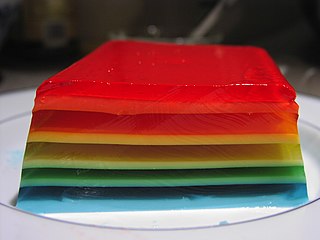
Gelatin desserts, also Jelly or Jello are desserts made with a sweetened and flavored processed collagen product (gelatin). This kind of dessert was first recorded as jelly by Hannah Glasse in her 18th-century book The Art of Cookery, appearing in a layer of trifle. Jelly is also featured in the best selling cookbooks of English food writers Eliza Acton and Isabella Beeton in the 19th century.

Dessert wines, sometimes called pudding wines in the United Kingdom, are sweet wines typically served with dessert.

Trifle is a layered dessert found in British and other cuisines. Made with a thin layer of sponge fingers commonly soaked in sherry or another fortified wine, custard and a fruit element, the contents of a trifle are highly variable; many varieties exist, some forgoing fruit entirely and instead using other ingredients, such as chocolate, coffee or vanilla. The fruit and sponge layers may be suspended in fruit-flavoured jelly, and these ingredients are usually arranged to produce three or four layers. The assembled dessert can be topped with whipped cream, or, more traditionally, syllabub.
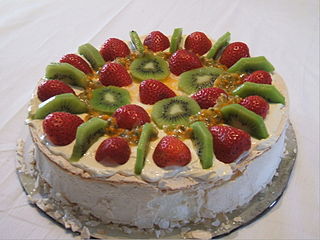
Pavlova is a meringue-based dessert named after the Russian ballerina Anna Pavlova. It has a crisp crust and soft, light inside, usually topped with fruit and whipped cream. The name is pronounced, or like the name of the dancer, which was.
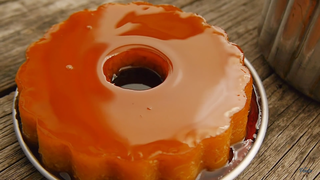
Pudding is a type of food that can be either a dessert or a savoury dish that is part of the main meal.

Gelato is a frozen dessert of Italian origin. Artisanal gelato in Italy generally contains 6-10% butterfat, which is lower than other styles of frozen dessert. Gelato typically contains 70% less air and more flavoring than other kinds of frozen desserts, giving it a density and richness that distinguishes it from other ice creams.
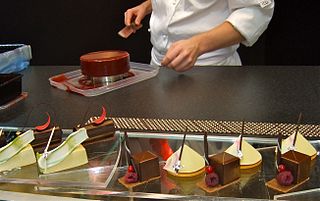
A pastry chef or pâtissier, is a station chef in a professional kitchen, skilled in the making of pastries, desserts, breads and other baked goods. They are employed in large hotels, bistros, restaurants, bakeries, and some cafés.

Halo-halo, also spelled haluhalo, Filipino for "mixed", is a popular cold dessert in the Philippines made up of crushed ice, evaporated milk or condensed milk, and various ingredients including: ube, sweetened beans, coconut strips, sago, gulaman (agar), pinipig rice, boiled taro or soft yams in cubes, slices or portions of fruit preserves and other root crop preserves, flan, and often topped with a scoop of ube ice cream. Halo-halo is considered to be the unofficial national dessert of the Philippines. The term "halo-halo" literally means "mixed [together]" in English. By extension, this spelling has come to describe any object or situation that is composed of a similar, colorful mélange of ingredients.

Tong sui, also known as tim tong, is a collective term for any sweet, warm soup or custard served as a dessert at the end of a meal in Cantonese cuisine. Tong sui are a Cantonese specialty and many varieties are rarely found in other regional cuisines of China. Outside of Cantonese-speaking communities, soupy desserts generally are not recognized as a distinct category, and the term tong sui is not used.

Ras malai or rossomalai or Rasamalei is a dessert originating from the eastern regions of the Indian subcontinent. The dessert is called rossomalai in Bengali, ras malai in Hindi, and Rasa Malei in Odia.
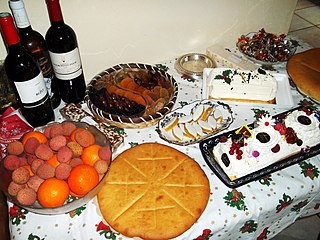
The thirteen desserts are the traditional dessert foods used in celebrating Christmas in the French region of Provence. The "big supper" ends with a ritual 13 desserts, representing Jesus Christ and the 12 apostles. The desserts always number thirteen but the exact items vary by local or familial tradition. The food traditionally is set out Christmas Eve and remains on the table three days until December 27.

Knafeh is a traditional Middle Eastern dessert made with spun pastry called kataifi, soaked in sweet, sugar-based syrup, and typically layered with cheese, or with other ingredients such as clotted cream, pistachio or nuts, depending on the region. It is popular in the Arab world, particularly Egypt and the Levant, being considered the most representative and iconic Palestinian dessert. Variants are also found in Turkey, Greece, and the Balkans.
Cuisine of the Ionian islands or Heptanesean cuisine in Greece is the cuisine of the Ionian Islands region. It has more influences from Italian cuisine than can be found in any other part of Greece due to the long period of Venetian rule in the Ionian Islands.













